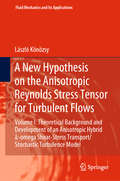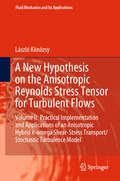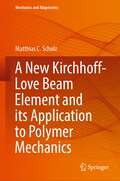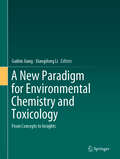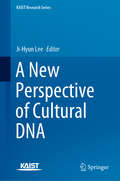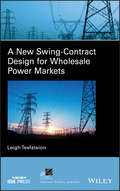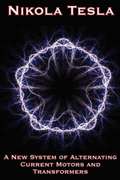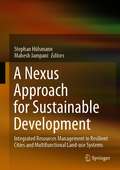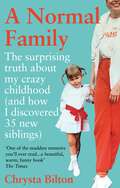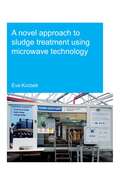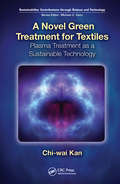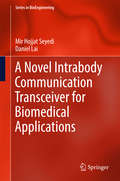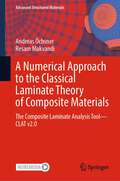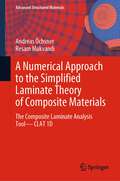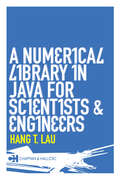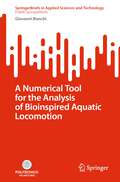- Table View
- List View
A New Hypothesis on the Anisotropic Reynolds Stress Tensor for Turbulent Flows: Volume I: Theoretical Background and Development of an Anisotropic Hybrid k-omega Shear-Stress Transport/Stochastic Turbulence Model (Fluid Mechanics and Its Applications #120)
by László KönözsyThis book gives a mathematical insight--including intermediate derivation steps--into engineering physics and turbulence modeling related to an anisotropic modification to the Boussinesq hypothesis (deformation theory) coupled with the similarity theory of velocity fluctuations. Through mathematical derivations and their explanations, the reader will be able to understand new theoretical concepts quickly, including how to put a new hypothesis on the anisotropic Reynolds stress tensor into engineering practice. The anisotropic modification to the eddy viscosity hypothesis is in the center of research interest, however, the unification of the deformation theory and the anisotropic similarity theory of turbulent velocity fluctuations is still missing from the literature. This book brings a mathematically challenging subject closer to graduate students and researchers who are developing the next generation of anisotropic turbulence models. Indispensable for graduate students, researchers and scientists in fluid mechanics and mechanical engineering.
A New Hypothesis on the Anisotropic Reynolds Stress Tensor for Turbulent Flows: Volume II: Practical Implementation and Applications of an Anisotropic Hybrid k-omega Shear-Stress Transport/Stochastic Turbulence Model (Fluid Mechanics and Its Applications #125)
by László KönözsyThis self-contained, interdisciplinary book encompasses mathematics, physics, computer programming, analytical solutions and numerical modelling, industrial computational fluid dynamics (CFD), academic benchmark problems and engineering applications in conjunction with the research field of anisotropic turbulence. It focuses on theoretical approaches, computational examples and numerical simulations to demonstrate the strength of a new hypothesis and anisotropic turbulence modelling approach for academic benchmark problems and industrially relevant engineering applications. This book contains MATLAB codes, and C programming language based User-Defined Function (UDF) codes which can be compiled in the ANSYS-FLUENT environment. The computer codes help to understand and use efficiently a new concept which can also be implemented in any other software packages. The simulation results are compared to classical analytical solutions and experimental data taken from the literature. A particular attention is paid to how to obtain accurate results within a reasonable computational time for wide range of benchmark problems. The provided examples and programming techniques help graduate and postgraduate students, engineers and researchers to further develop their technical skills and knowledge.
A New Kirchhoff-Love Beam Element and its Application to Polymer Mechanics (Mechanics and Adaptronics)
by Matthias C. SchulzThe novel finite element formulations fall into the category of geometrically exact Kirchhoff-Love beams. A prominent characteristic of this category is that the absence of shear deformation is strongly enforced by removing two degrees of freedom. Further, the corresponding beam theories exhibit not only translational but also rotational degrees of freedom and their configurations thus form a non-additive and non-commutative space. Sophisticated interpolation schemes are required that need to be tested not only for locking, spatial convergence behavior, and energy conservation, but also for observer invariance and path-independence. For the three novel beam element formulations all these properties are analytically and numerically studied and confirmed, if applicable. Two different rotation parameterization strategies are employed based on the well-known geodesic interpolation used in many Simo-Reissner beams and the lesser known split into the so-called \textit{smallest rotation} and a torsional part. Application of the former parameterization results in a mixed finite element formulation intrinsically free of locking phenomena. Additionally, the first geometrically exact Kirchhoff-Love beam element is presented, which strongly enforces inextensibility by removing another degree of freedom. Furthermore, the numerical efficiency of the new beam formulations is compared to other beam elements that allow for or suppress shear deformation. When modeling very slender beams, the new elements offer distinct numerical advantages.Standard molecular dynamics simulations, which are commonly used to study polymers, suffer from a lack of a careful mathematical basis and the use of an expensive explicit time integration scheme. To circumvent these shortcomings and to be able to simulate stretching experiments on relevant time scales, the problem is described by a stochastic partial differential equation, which can be solved using the finite element method with a backward Euler temporal discretization. In detail, the polymer is represented by a Kirchhoff-Love beam with a linear elastic constitutive model. Inertial and electrostatic forces are neglected. It is deformed by a distributed load mimicking collisions with molecules of the surrounding fluid. Naturally, this load heavily fluctuates over time and space and mean values need to be computed in a Monte Carlo manner. To vastly speed up the fitting process to experimental data in a Bayesian framework, a surrogate model based on a Gaussian process is set up, which directly computes the mean values for given material parameters. The uncertainties and correlations of the material parameters are studied and compared to the literature.
A New Meta-heuristic Optimization Algorithm Based on the String Theory Paradigm from Physics (SpringerBriefs in Applied Sciences and Technology)
by Luis Rodriguez Oscar CastilloThis book focuses on the fields of nature-inspired algorithms, optimization problems and fuzzy logic. In this book, a new metaheuristic based on String Theory from Physics is proposed. It is important to mention that we have proposed the new algorithm to generate new potential solutions in optimization problems in order to find new ways that could improve the results in solving these problems. We are presenting the results for the proposed method in different cases of study. The first case, is optimization of traditional benchmark mathematical functions. The second case, is the optimization of benchmark functions of the CEC 2015 Competition and we are also presenting results of the CEC 2017 Competition on Constrained Real-Parameter Optimization that are problems that contain the presence of constraints that alter the shape of the search space making them more difficult to solve. Finally, in the third case, we are presenting the optimization of a fuzzy inference system, specifically for finding the optimal design of a fuzzy controller for an autonomous mobile robot. It is important to mention that in all study cases we are presenting statistical tests in or-der to validate the performance of proposed method. In summary, we believe that this book will be of great interest to a wide audience, ranging from engineering and science graduate students, to researchers and professors in computational intelligence, metaheuristics, optimization, robotics and control.
A New Paradigm for Environmental Chemistry and Toxicology: From Concepts to Insights
by Guibin Jiang Xiangdong LiThis book provides comprehensive coverage of the theoretical developments and technological breakthroughs that have deepened our understanding of environmental pollution and human health, while also promoting a comprehensive strategy to address these problems. The respective chapters highlight groundbreaking concepts fueling the development of environmental chemistry and toxicology; revolutionary analytical and computational approaches providing novel insights into environmental health; and nature-inspired, innovative engineering solutions for tackling complex hazardous exposures. The book also features a forward-looking perspective on emerging environmental issues that call for new research and regulatory paradigms, laying the groundwork for future advances in the broad field of environmental chemistry and toxicology. Written by respected authorities in the field, A New Paradigm for Environmental Chemistry and Toxicology - From Concepts to Insights will offer an invaluable reference guide for concerned researchers and professional practitioners for years to come.
A New Perspective of Cultural DNA (KAIST Research Series)
by Ji-Hyun LeeThis book presents selected papers from the 3rd Cultural DNA Workshop. Contributed by prominent computational design experts in the fields of mechanical engineering and architectural design, they mainly focus on the design process; shape grammars as a valuable tool; and the analysis of cultural values.The book offers readers fresh viewpoints on computational design. and helps researchers in academy and practitioners in industry to learn more evolved cultural DNA knowledge which is newly interpreted and conceptually reinforced in areas of mechanical engineering and architectural engineering.
A New Swing-Contract Design for Wholesale Power Markets (IEEE Press Series on Power and Energy Systems)
by Leigh TesfatsionProvides comprehensive information on swing contracts for flexible reserve provision in wholesale power markets This book promotes a linked swing-contract market design for centrally-managed wholesale power markets to facilitate increased reliance on renewable energy resources and demand-side participation. The proposed swing contracts are firm or option two-part pricing contracts permitting resources to offer the future availability of dispatchable power paths (reserve) with broad types of flexibility in their power attributes. A New Swing-Contract Design for Wholesale Power Markets begins with a brief introduction to the subject, followed by two chapters that cover: general goals for wholesale power market design; history, operations, and conceptual concerns for current U.S. RTO/ISO-managed wholesale power markets; and the relationship of the present study to previous swing-contract research. The next eight chapters cover: a general swing-contract formulation for centrally-managed wholesale power markets; illustrative swing-contract reserve offers; inclusion of reserve offers with price swing; inclusion of price-sensitive reserve bids; and extension to a linked collection of swing-contract markets. Operations in current U.S. RTO/ISO-managed markets are reviewed in the following four chapters, and conceptual and practical advantages of the linked swing-contract market design are carefully considered. The book concludes with an examination of two key issues: How might current U.S. RTO/ISO-managed markets transition gradually to a swing-contract form? And how might independent distribution system operators, functioning as linkage entities at transmission and distribution system interfaces, make use of swing contracts to facilitate their participation in wholesale power markets as providers of ancillary services harnessed from distribution-side resources? In summary, this title: Addresses problems with current wholesale electric power markets by developing a new swing-contract market design from concept to practical implementation Provides introductory chapters that explain the general principles motivating the new market design, hence why a new approach is required Develops a new type of swing contract suitable for wholesale power markets with increasing reliance on renewable energy and active demand-side participation A New Swing-Contract Design for Wholesale Power Markets is an ideal book for electric power system professionals and for students specializing in electric power systems.
A New System of Alternating Current Motors and Transformers and Other Essays
by Nikola TeslaNikola Tesla was a genius who revolutionized how the world looks at electricity. During college his professors explained that it was impossible to design an engine without commutators or brushes. Tesla was unconvinced that such was necessary or even particularly desirable. It was then that Tesla began his work on the rotating field motor that ultimately gave birth to the modern age. In May of 1888, Tesla delivered his lecture "A New System of Alternating Current Motors and Transformers" before The American Institute of Electrical Engineers and the world has never been the same.
A New Target Detector Based on Geometrical Perturbation Filters for Polarimetric Synthetic Aperture Radar (Springer Theses)
by Armando MarinoThis thesis presents a groundbraking methodology for the radar international community. The detection approach introduced, namely perturbation analysis, is completey novel showing a remarkable capability of thinking outside the box. Perturbation analysis is able to push forward the performance limits of current algorithms, allowing the detection of targets smaller than the resolution cell and highly embedded in clutter. The methodology itself is extraordinary flexibe and has already been used in two other large projects, funded by the ESA (European Space Agency): M-POL for maritime surveillance, and DRAGON-2 for land classification with particular attention to forests. This book is a perfectly organised piece of work where every detail and perspective is taken into account in order to provide a comprehensive vision of the problems and solutions.
A New Theory of Additive Manufacturing: Solvable and Unsolvable Manufacturing Problems (Synthesis Lectures on Engineering, Science, and Technology)
by Sanjay KumarThis is the first book on Additive Manufacturing that provides an original theory for the entire subject. It is the culmination of a search for the root cause of manufacturing problems that occur in practice. The author finds a reason why there are only two types of layer arrangement for manufacturing products and divides fabrication problems in additive manufacturing into two types: solvable and unsolvable. This allows readers to anticipate/avoid difficulty in manufacturing, saving materials, time, and resources.
A Nexus Approach for Sustainable Development: Integrated Resources Management in Resilient Cities and Multifunctional Land-use Systems
by Stephan Hülsmann Mahesh JampaniThis book explores how integrated management of environmental resources via a nexus approach can help in achieving the respective Sustainable Development Goals (SDGs). It provides conceptual considerations but mainly practical examples on how to implement a nexus approach in cities and multifunctional land-use systems to increase resource use efficiency and develop a low carbon economy. After sketching out the background and conceptual outline, contributions to the book explore key aspects of the nexus implementation. Specifically, they • Demonstrate how to sustainably use organic waste and wastewater for agriculture, • Explore examples on how to manage multifunctional land-use systems including multipurpose reservoirs, • Highlight the importance of economic incentives for successful nexus implementation, and • Provide a comprehensive perspective on challenges and opportunities of implementation, considering peer-to-peer learning, indigenous knowledge, and stakeholder participation. The chapters in this book shed a new light on key aspects of the interrelation between SDGs and the nexus approach in resilient cities and multifunctional land-use systems, and provide specific examples on how to advance sustainable resources management.
A Night to Remember: The Sinking of the Titanic (The Titanic Chronicles #1)
by Walter Lord#1 New York Times Bestseller: The definitive book on the sinking of the Titanic, based on interviews with survivors, by the author of The Miracle of Dunkirk. At first, no one but the lookout recognized the sound. Passengers described it as the impact of a heavy wave, a scraping noise, or the tearing of a long calico strip. In fact, it was the sound of the world&’s most famous ocean liner striking an iceberg, and it served as the death knell for 1,500 souls. In the next two hours and forty minutes, the maiden voyage of the Titanic became one of history&’s worst maritime accidents. As the ship&’s deck slipped closer to the icy waterline, women pleaded with their husbands to join them on lifeboats. Men changed into their evening clothes to meet death with dignity. And in steerage, hundreds fought bitterly against certain death. At 2:15 a.m. the ship&’s band played &“Autumn.&” Five minutes later, the Titanic was gone. Based on interviews with sixty-three survivors, Lord&’s moment-by-moment account is among the finest books written about one of the twentieth century&’s bleakest nights.
A Normal Family: The Surprising Truth About My Crazy Childhood (And How I Discovered 35 New Siblings)
by Chrysta BiltonONE OF PEOPLE MAGAZINE'S BEST SUMMER READS 20225* 'A jaw-dropping memoir' - THE TELEGRAPH'One of the maddest memoirs you'll read this year... a beautiful, warm, funny book.' -The Times'A wholly absorbing page-turner that everyone will want to read. You should probably buy two.' -Kirkus Starred Review'A riveting debut.' -People Magazine'By turns hilarious, wrenching, and achingly tender.' -Susan Orlean, New York Times bestselling author'A remarkable and wise book, two memoirs braided together with such tendresse that readers will come to believe the ironic title in earnest' -LA TIMESFor most of her life, Chrysta Bilton was one member of a small, if dysfunctional, family of four. There was her sister, Kaitlyn, her hedonistic, glamorous, gay mum Debra, and Jeffrey, who Debra hand-picked, in an LA hairdressers, to be the father of her children. During Chrysta's unstable childhood, Debra struggled to keep the family afloat and Jeffrey wandered in and out of their lives.Then, in her twenties, Chrysta discovered that her father had secretly donated his sperm over 500 times - and that she had at least 35 other siblings.A Normal Family is a captivating coming-of-age memoir about Chrysta's reckoning with the secrets both parents had carefully kept from her. Heartfelt, warm and funny, it's a story of embracing the family we have, in all the forms we find it.
A Normal Family: The Surprising Truth About My Crazy Childhood (And How I Discovered 35 New Siblings)
by Chrysta Bilton'I thought my family was complicated until I read Chrysta Bilton's wonderful memoir about the unique collection of irresistible characters in her life. Bilton has a big heart, gentle wisdom, keen eye and lovely wit. She's a gifted writer with an astonishing story to tell.' -David Sheff, author of Beautiful Boy'By turns hilarious, wrenching, and achingly tender... Bilton writes beautifully, with sharp insight and a light touch, about her harrowing, astonishing journey into understanding her parents, her (very) extended family, and herself.' - Susan Orlean, New York Times bestselling author of On Animals and Rin Tin TinFor most of her life, Chrysta Bilton was one member of a small, if dysfunctional, family of four. There was her sister, Kaitlyn, her hedonistic, glamorous, gay mum Debra, and Jeffrey, who Debra hand-picked, in an LA hairdressers, to be the father of her children. During Chrysta's unstable childhood, Debra struggled to keep the family afloat and Jeffrey wandered in and out of their lives.Then, in her twenties, Chrysta discovered that her father had secretly donated his sperm over 500 times - and that she had at least 35 other siblings.A Normal Family is a captivating coming-of-age memoir about Chrysta's reckoning with the secrets both parents had carefully kept from her. Heartfelt, warm and funny, it's a story of embracing the family we have, in all the forms we find it.
A Novel Approach to Sludge Treatment Using Microwave Technology (IHE Delft PhD Thesis Series)
by Eva KocbekSludge transportation costs can represent a large fraction of the expenses associated with municipal and faecal sludge management. These costs can be mitigated through the use of thermal drying approaches to reduce the sludge volume. This thesis described the application of a novel microwave-based pilot-scale unit as an alternative technology for the sanitisation and drying of sludge from municipal wastewater treatment plants and on-site sanitation facilities. The potential economic benefits of volumetric heating, moisture levelling, and increased liquid and vapour migration from the interior to the surface of the product underpins the increasing interest in the use of microwave technology during sludge treatment processes. According to the findings of this study, these factors lead to faster processing times, improved drying rates, and a reduced physical footprint. Furthermore, microwave technology operates as a standalone treatment unit. When coupled with mechanical dewatering techniques and membrane separation technology, it can increase the reliability of the technology employed in the treatment of sludge while recovering valuable resources through an agricultural or thermochemical application such as (co-) combustion. The results of this work demonstrate the strong feasibility of applying microwave-based technology within initiatives designed to protect the environment and safeguard public health.
A Novel Green Treatment for Textiles: Plasma Treatment as a Sustainable Technology (ISSN)
by Chi-wai KanIndustries worldwide have been impacted by environmental regulations, economics, and ultimately consumers, which has led to more thought about the development of sustainable products. The textile industry is no exception. The preparation, dyeing, and finishing of textile fibres requires large amounts of water and other chemicals which may be toxic
A Novel Intrabody Communication Transceiver for Biomedical Applications (Series in BioEngineering)
by Mir Hojjat Seyedi Daniel LaiThis monograph explores Intrabody communication (IBC) as a novel non-RF wireless data communication technique using the human body itself as the communication channel or transmission medium. In particular, the book investigates Intrabody Communication considering limb joint effects within the transmission frequency range 0. 3-200 MHz. Based on in-vivo experiments which determine the effects of size, situations, and locations of joints on the IBC, the book proposes a new IBC circuit model explaining elbow joint effects. This model not only takes the limb joint effects of the body into account but also considers the influence of measurement equipment in higher frequency band thus predicting signal attenuation behavior over wider frequency ranges. Finally, this work proposes transmitter and receiver architectures for intrabody communication. A carrier-free scheme based on impulse radio for the IBC is implemented on a FPGA.
A Novel Lidar Ceilometer: Design, Implementation and Characterisation (Springer Theses)
by Joshua D. Vande HeyIn this thesis, a new lidar (light detection and ranging) ceilometer capable of monitoring cloud base and sensitive to boundary layer aerosols is introduced. The key to this novelty lies in its divided-lens design that addresses a classical lidar problem of balancing transmitter-receiver overlap and signal-to-noise ratio, along with a method for characterizing overlap in the laboratory. Enhanced sensitivity in the near-range of the instrument is achieved without compromising signal-to-noise in a design that is straightforward to manufacture for broad deployment. The instrument, its optical characterization, and its performance in the field are described. The prototype instrument described here has since formed the basis of a commercial sensor for monitoring clouds and aerosols. High-resolution, continuous observations of clouds and aerosols are needed to reduce the large uncertainties in our current understanding of their influence on climate that have been highlighted by the International Panel on Climate Change. And as international health organizations indicate growing public health threats over the coming decades resulting from poor air quality, extensive aerosol monitoring is required to assess personal exposure to and the health impacts of anthropogenic particulates. Ground-based optical remote sensing measurements made by well-characterized instruments, such as that described in these pages, are critical to this.
A Novel SOFC Tri-generation System for Building Applications (Springer Theses)
by Theo ElmerThe thesis has critically examined, both theoretically and experimentally, a novel tri-generation system concept - with encouraging system performance demonstrated. The thesis establishes the significant potential of the novel tri-generation system in providing effective built environment decarbonisation through decentralised generation; strengthening the case for a future hydrogen economy. In response to the critical need to decarbonise the built environment, alternative methods for more effective energy utilisation need to be explored including tri-generation systems. The thesis presents the design, development and testing of a novel proof-of-concept tri-generation system based on solid oxide fuel cell (SOFC) and liquid desiccant air conditioning technology to provide electricity, heating and cooling to building applications. No previous work has been reported on such a system. The theme of the work sits within the topics of low-carbon and sustainable energy technologies, building services and low carbon building applications.
A Numerical Approach to the Classical Laminate Theory of Composite Materials: The Composite Laminate Analysis Tool—CLAT v2.0 (Advanced Structured Materials #189)
by Andreas Öchsner Resam MakvandiThis book first provides a systematic and thorough introduction to the classical laminate theory for composite materials based on the theory for plane elasticity elements and classical (shear-rigid) plate elements. The focus is on unidirectional lamina which can be described based on orthotropic constitutive equations and their composition to layered laminates. In addition to the elastic behavior, failure is investigated based on the maximum stress, maximum strain, Tsai-Hill, and the Tsai-Wu criteria.The solution of the fundamental equations of the classical laminate theory is connected with extensive matrix operations, and many problems require in addition iteration loops. Thus, a classical hand calculation of related problems is extremely time consuming. In order to facilitate the application of the classical laminate theory, we decided to provide a Python-based computational tool, the so-called Composite Laminate Analysis Tool (CLAT) to easily solve some standard questions from the context of fiber-reinforced composites. The tool runs in any standard web browser and offers a user-friendly interface with many post-processing options. The functionality comprises stress and strain analysis of lamina and laminates, derivation of off-axis elastic properties of lamina, and the failure analysis based on different criteria.
A Numerical Approach to the Micromechanics of Fibre-Reinforced Laminae: The Micromechanics Analysis Tool—MMAT v1.0 (Advanced Structured Materials #218)
by Andreas Öchsner Resam MakvandiThis book treats the micromechanics of laminae, i.e., the prediction of the macroscopic mechanical lamina properties based on the mechanical properties of the constituents, i.e., fibers and matrix. The focus is on unidirectional lamina which can be described based on orthotropic constitutive equations. In detail, predictions for the modulus of elasticity in and transverse to the fiber direction, the major Poisson’s ratio, as wells as the in-plane shear modulus are provided. The mechanics of materials approach, the elasticity solutions with contiguity after Tsai, and the Halpin-Tsai relationships, are presented in detail. Composite materials, especially fiber-reinforced composites, are gaining increasing importance since they can overcome the limits of many structures based on classical engineering materials. Particularly the combination of a matrix with fibers provides far better properties than the single constituents alone. A typical basic layer, the so-called lamina, can be composed of unidirectional fibers which are embedded in a matrix. In a second step, layers of laminae may be stacked under different fiber angles to a so-called laminate, which reveals—depending on the stacking sequence—different types of anisotropy/isotropy. A Python-based computational tool is provided, the so-called Micromechanics Analysis Tool (MMAT v1.0) to easily predict the elastic properties. The tool runs in any standard web browser and offers a user-friendly interface with many graphical representations of the elastic properties as a function of the fiber volume fraction.
A Numerical Approach to the Simplified Laminate Theory of Composite Materials: The Composite Laminate Analysis Tool—CLAT 1D (Advanced Structured Materials #202)
by Andreas Öchsner Resam MakvandiA typical approach to treat composite materials, which are composed of layered unidirectional lamina, is the so-called classical laminate theory (CLT). This theory is based on the theory for plane elasticity elements and classical (shear-rigid) plate elements under the assumption of orthotropic constitutive equations. The solution of the fundamental equations of the classical laminate theory is connected with extensive matrix operations and many problems require in addition iteration loops.This two-dimensional approach and the underlying advanced continuum mechanical modeling might be very challenging for some students, particularly at universities of applied sciences. Thus, a reduced approach, the so-called simplified classical laminate theory (SCLT), has been recently proposed. The idea was to use solely isotropic one-dimensional elements, i.e., a superposition of bar and beam elements, to introduce the major calculation steps of the classical laminate theory. Understanding this simplified theory is much easier and the final step it to highlight the differences when moving to the general two-dimensional case.This monograph first provides a systematic and thorough introduction to the simplified laminate theory based on the theory for bars and classical beam plate elements. The focus is on stacking of isotropic layers to simplified laminates. In addition to the elastic behavior, failure is investigated based on the maximum stress, maximum strain, Tsai-Hill, and the Tsai-Wu criteria. We provide a Python-based computational tool, the so-called Composite Laminate Analysis Tool (CLAT 1D) to easily solve some standard questions from the context of fiber reinforced composites. The tool runs in any standard web browser and offers a user-friendly interface with many post-processing options. The functionality comprises stress and strain analysis of simplified lamina and laminates and the failure analysis based on different criteria.
A Numerical Library in Java for Scientists and Engineers
by Hang T. LauAt last researchers have an inexpensive library of Java-based numeric procedures for use in scientific computation. The first and only book of its kind, A Numeric Library in Java for Scientists and Engineers is a translation into Java of the library NUMAL (NUMerical procedures in ALgol 60). This groundbreaking text presents procedural descr
A Numerical Primer for the Chemical Engineer, Second Edition
by Edwin ZondervanDesigned as an introduction to numerical methods for students, this book combines mathematical correctness with numerical performance, and concentrates on numerical methods and problem solving. It applies actual numerical solution strategies to formulated process models to help identify and solve chemical engineering problems. Second edition comes with additional chapter on numerical integration and section on boundary value problems in the relevant chapter. Additional material on general modelling principles, mass/energy balances and separate section on DAE’s is also included. Case study section has been extended with additional examples.
A Numerical Tool for the Analysis of Bioinspired Aquatic Locomotion (SpringerBriefs in Applied Sciences and Technology)
by Giovanni BianchiThis book presents a novel method for the numerical simulation of swimming animals. It includes a review of the hydrodynamics of swimming, a description of the CFD model adopted, and a description of the results obtained by applying this model to the cownose ray. This method is developed for the open-source software OpenFOAM and relies on an overset mesh. A custom library is added to the solver to include the equations of the kinematics of the animal under investigation, combining the deformation of the fish fins with the computed displacement and rotation of the animal's body. The presented method helps investigate the dynamics of any animal moving in a fluid, provided that its kinematics is known, and in this work, it is applied to investigate the hydrodynamics of a cownose ray. This book is intended for researchers and engineers who aim to deeply understand the hydrodynamics of fish swimming and to design bioinspired autonomous underwater vehicles or novel propulsion systems.
